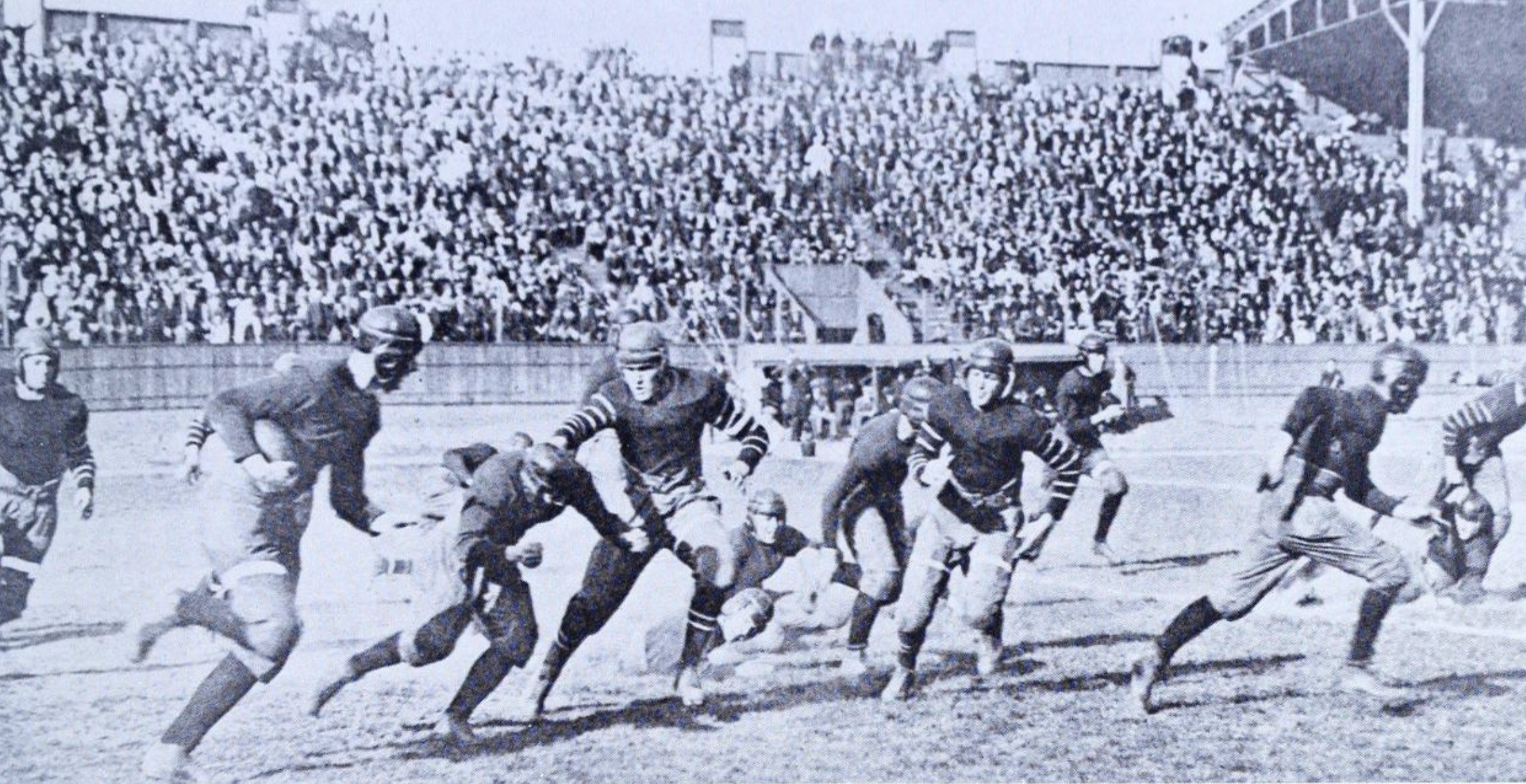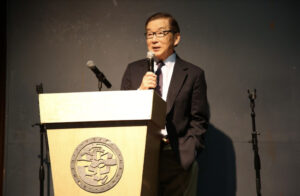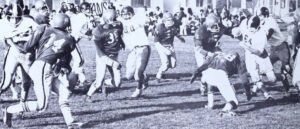
Courtesy of the LWHS Archives
Whenever a classic movie about the high school experience comes on TV, it seems as though football is always involved. But why? — one might ask. The short answer is that America and its schools adopted football culture for its pageant of battle and heroism. Archie Andrews on the show Riverdale says, one of the most important things in life is “[knowing] the triumphs and defeats, the epic highs and lows of high school football.”
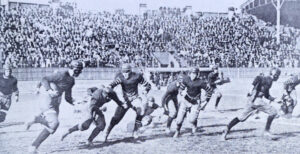
Courtesy of the LWHS Archives
“I watched the movies: you go to high school and you play football.” –Erich Stratmann ’57
Believe it or not, Lick-Wilmerding High School (LWHS) once had a powerhouse football program. The earliest record in the LWHS archives of the program’s existence is a photo of the team from 1903.
LWHS competed in the local San Francisco Athletic League (SFAL), under the broader Academic Athletic Alliance (AAA) league. The SFAL consisted of San Francisco high schools Lowell, St. Ignatius, Mission, Polytechnic, and Cogswell through 1921, before Commerce, Sacred Heart Preparatory, and Galileo joined in 1921. From 1912 to 1921, the SFAL played a sport that was more of a cross between rugby and football. While the league continued rugby football for another year, LWHS split off from the league in 1920 to return to American football. The next year, all SFAL schools followed suit.
“LWHS during the 1910s was a major football powerhouse,” –Ken Sproul ’57
Football at LWHS not only existed for over 80 years, but was a successful program and a powerhouse up through the 1920s. Not including nominations prior to 1922, an astounding 41 LWHS players made the rosters on the CIF AAA division all-star teams between 1922 and 1960.
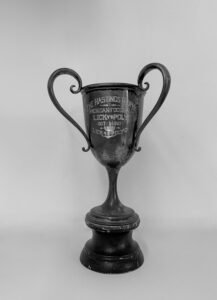
Courtesy of the LWHS Archives
LWHS football dominated the SFAL teams, appearing in city championships almost yearly until dropping out of the SFAL in 1931. LWHS won the San Francisco championship titles in 1917, 1918, 1921, 1922, 1925, and 1926. Many of the championship games were played at the long-gone Ewing Field, located on Lone Mountain in San Francisco. Ewing Field, a fiasco of a baseball field, found its niche as a football field that drew thousands of spectators to high school football matches during its heyday.
In 1910, 1921, and 1923, LWHS made appearances in the North Coast Section (NCS) Football Championships. LWHS beat Berkeley High School (Berkeley) in the 1910 home game, played at Ewing Field, and in 1923. After beating Berkeley 20-16 on their home turf, the football team advanced to the California Interscholastic Federation (CIF) State Football Championship of 1923, but failed to pull through against Bakersfield High School in a hard-fought game.
“We had a horrible locker room, bad equipment, not very good coaches, but we still won some games. Everybody played sports — I signed up for the team, and at least in my mind there was no pecking order involved.” –Ken Sproul ’57
The football program, scrappy and unusual as it was, was also similar to most football programs, in its overzealous coaching and extreme training.
“I was a halfback and they decided that they would work us out, and I remember they had me running against this guy about 30 times, with him tackling me and me trying to get by him. And it was a hot day, and we were just doing this over and over.” –Rick Bost ’57
Football was a major source of school pride at LWHS, adding to campus life with pep rallies and sporting events. Much of the school showed up at the games. The general public also took a great interest in the games and showed up to watch. The SFAL championship games were arguably the most exciting football games around that the public could watch within reasonable distance of San Francisco, and these, in particular, had attendance that reached well into the thousands.
While today it is unlikely for a Lowell-LWHS matchup to occur in a given season, in the past, the two schools frequently competed head to head, finding themselves facing off yet again many times for the SFAL Championships. The relationship was similar and comparable to that of the LWHS relationship today with University High School of San Francisco.
Small booklets with cheers found in the LWHS archives demonstrate the high levels of school spirit at pep rallies before a game against Lowell. These cheers included everything from short one-liners to entire songs with the lyrics changed to align with LWHS’ goals for that game.
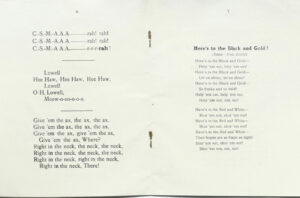
Courtesy of the LWHS Archives
Students would shout, “Here’s to the black and gold” repeatedly, as well as mockingly mentioning Lowell, immediately followed by the chant “give ‘em the ax, the ax, the ax…right in the neck, right in the neck!”
The last official LWHS football game was played in 1974, two years after LWHS became co-ed once again, and from that point forward, the only football games students competed as flag football in intramural leagues.
To answer the question of why football no longer exists at LWHS, one explanation is due to the sport being detrimental to players’ long-term health and quality of life. Despite players wearing helmets and other protective gear while playing, the reality is that people of all ages playing at different levels of competition are at very high risk for concussions and other head injuries.
In a study conducted by Dr. Ann McKee, MD, the brains of 12 football players showed signs of Chronic Traumatic Encephalopathy (CTP) over a two-year period. The symptoms of CTP are severe and long-term, including emotional issues and memory loss.
Head of School Eric Temple observed, “I know [sports equipment engineers] are trying to create helmets that are better. But you know, adolescent brains are so vulnerable. I can’t consciously put kids in that situation — to me, it just would be unethical.”
The culture surrounding football is another instance where the values of the sport differ from those found at LWHS. “I think that football in certain schools in different parts of the country can lead to trends of hyper-masculinity or toxic masculinity and that has traditionally been the culture around the sport,” Temple said.
The football team at LWHS was also discontinued due to the cost of running a football program. Football is an expensive sport to fund — on top of insurance, equipment including pads and helmets for a team with such a large roster runs up the costs, as does paying the larger coaching staff that comes with football.
It is uncommon for football to be played at smaller private schools in the Bay Area. None of the current opponents of LWHS in the local league in which the school competes, Bay Area Conference League-West (BCL-West), currently have football teams.
Football as a sport has space for a few players and many fans. Without football, LWHS students have more opportunities to participate in a variety of other sports. Currently, the school offers twenty-one sports for boys and girls, including varsity-level teams to frosh teams for some sports. LWHS fields a boys and girls team for cross country, tennis, water polo, basketball, soccer, badminton, lacrosse, swimming, and track & field. Additionally, there is a girls field hockey team, girls volleyball team, boys baseball team and girls softball team.
LWHS Athletic Director Eliot Smith has been working at LWHS since 1987. “Boys and girls volleyball were some of the most popular sports at the time, and they were very successful,” he said. Talking about the process of starting a new sports team, Smith mentioned that the process is very “student-driven.” When a student approaches Smith with a request to play a new sport, a member of the athletic department first has to “sit down and talk about what is needed: we need facilities, coaches, uniforms, a budget, and then we have to figure out what league we can get into,” he said.
New sports are often started as student-led clubs. Some newer teams participate in games outside of BCL-West if the sport is not currently offered, sometimes moving over to the East, North, or Central leagues or playing in the broader Bay Area Conference that includes teams from all of those branches.
Some sports are currently in various stages of being added to LWHS student’s choices: in recent years there has been a reignition of interest in a boys’ volleyball team. The golf club was rejuvenated this past school year and next fall will be Flag Football’s second year with a full schedule of league games. Additionally, Ultimate Frisbee is offered as a fun sport in the fall season, where participants get to just scrimmage and play around.
Some of the competitive successes of new sports begun in recent years include girls softball and girls field hockey.
While football was the star of the show in the past, the sports that currently shine in the spotlight include cross country, basketball and soccer. Cross country has notably been on the rise in popularity in the past few decades. Around a under 100 students participate each year in the program. The program attracts many first-year students.
While these sports are very popular at LWHS, the only event that comes close to matching the level of school spirit at the rallies before the historic football games against Lowell are the annual basketball game against UHS at the Chase Center and the “Kick-Wilmerding” soccer game against Urban High School at Kezar Stadium.
These annual games draw out intense and much-needed school spirit and provide a space for community bonding. The boys’ and girls’ varsity basketball matchups against UHS at Chase Center are a whole school affair during the school day. The athletic department charters yellow school buses to carry students across the city to compete or watch and cheer.
The Kick-Wilmerding soccer game at Kezar Stadium is a more recent addition to traditions at LWHS. It is the closest event to the historic football games once played at Ewing Field and Kezar. Even during the COVID-19 pandemic, LWHS students came out to support their peers competing at soccer, eat some good food, and of course, participate in the Lick-Wilmerding chant.
Maybe football used to be the center of the high school experience, but today the focus is more on school spirit and supporting athletes in every sport. Many students at LWHS play at least one sport if not more than that, and big playoff games frequently draw out a large crowd of students. There may not be an official cheer book with targeted chants, but there is an enthusiastic and competitive student body composed of athletes and dedicated fans.




